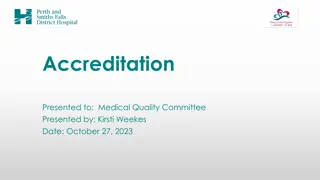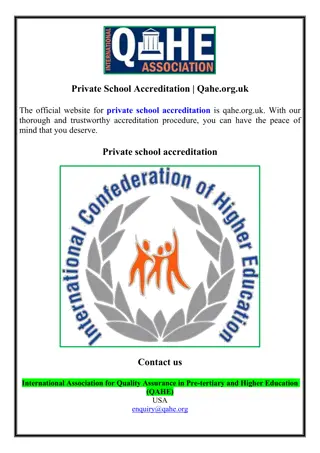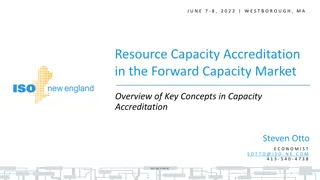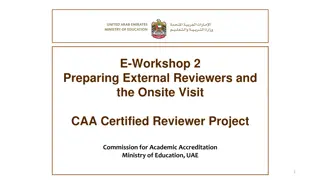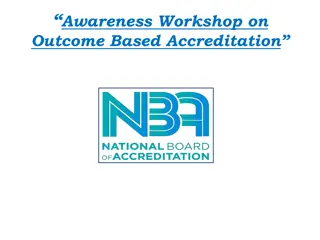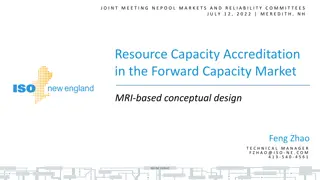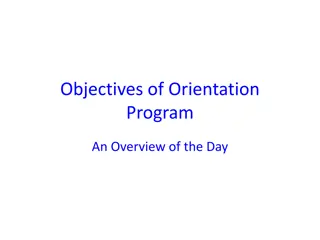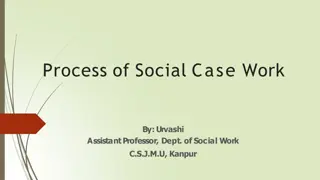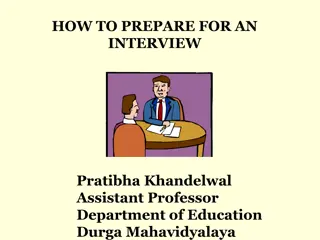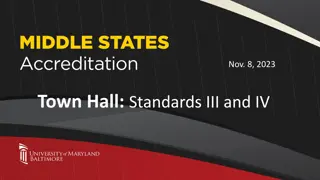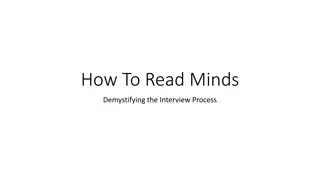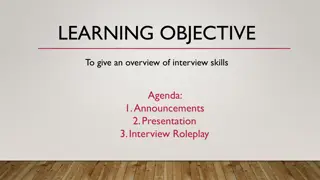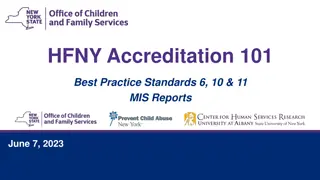Conducting an Initial Interview with a Family Law Client for Accreditation
This simulated first interview aims to assess the candidate's ability in interacting with a client, taking instructions, giving advice, and developing an initial plan in the context of family law. Key assessment criteria include gathering and assessing instructions, giving advice, demonstrating rapport and empathy, and communicating clearly. The process involves steps like establishing issues, setting ground rules, gathering facts, advising the client, and assisting with decision-making. Extracting basic facts such as parties' details, marriage/separation dates, property ownership, occupations, income, and children's schooling is crucial in initiating the interview effectively.
Download Presentation

Please find below an Image/Link to download the presentation.
The content on the website is provided AS IS for your information and personal use only. It may not be sold, licensed, or shared on other websites without obtaining consent from the author.If you encounter any issues during the download, it is possible that the publisher has removed the file from their server.
You are allowed to download the files provided on this website for personal or commercial use, subject to the condition that they are used lawfully. All files are the property of their respective owners.
The content on the website is provided AS IS for your information and personal use only. It may not be sold, licensed, or shared on other websites without obtaining consent from the author.
E N D
Presentation Transcript
Conducting an Initial Interview with a Family Law Client for Accreditation The candidate will conduct a simulated first interview with a person acting in the role of the client. The simulated interview is intended to assess a wide range of performance standards including those relating to interaction between a solicitor and client, taking instructions and giving advice, terms of engagement, assessing facts and legal options, canvassing options with the client and developing the initial plan.
Conducting an Initial Interview with a Family Law Client for Accreditation The candidate is expected to demonstrate a clear ability to take and receive instructions, deliver preliminary advice and provide information to the client in a manner which satisfies the assessment criteria, core knowledge and performance standards. You will be marked on the way you demonstrate your knowledge of the law in the context of the matters which arise during the interview. How you communicate your knowledge to the client in the context of a first interview, will be relevant.
Accreditation Setting Up The candidate may bring written material to the interview including instruction sheets or notes. None of this will form part of the assessment.
Assessment Criteria (Summary) Candidates will be assessed on the following: 1. Their ability to gather and assess instructions; 2. Their ability to give advice; 3. Evidence of rapport, empathy, attitude; and 4. Ability to communicate clearly and appropriately.
Five Basic Steps - Interview Process 1. 2. 3. 4. 5. Establishing the issues; Setting the ground rules; Gathering the facts; Advising the client; Assisting the client to make decisions.
Extract the basic facts The best way to commence an interview is to extract the basic facts: 1. DOB of and names of parties and children; 2. Date and place of marriage and separation; 3. Outline of property owned; 4. Occupations and income; 5. Children s schooling. Note that all of the above are closed questions .
Step 1: Establishing the Issues The initial question solicitors often ask a Family Law client is: How can I help you? One of two responses is likely: 1. Rambling answer where the client loses their way; 2. Where do I start? There are better ways to commence an interview. The first question is important as it is essential not to lose control of the interview at the outset: you have limited time and you have to know as soon as possible all the things you need to give advice about. In the initial stage you should establish an understanding of the issues involved in the client matter in broad terms.
What sort of questions should you ask at Step 1? The aim now is to: 1. Establish rapport with the client; 2. Listen to the client s own description of the reasons the client came to see you; 3. Identify the major issue or issues of concern. Bear in mind that as a lawyer we are a complete stranger to the client and much of what we need to know is very private to the client. Some clients need reassurance as to confidentiality and the reasons we ask the questions we do. You may need to explain this. Be sensitive to the client s anxiety and stress and acknowledge it when possible and appropriate
Confidentiality One of the first matters you could raise with the client is that of confidentiality. Tell the client you regard confidentiality as being of paramount importance. Explain our professional obligations towards the client: To keep their affairs absolutely private; and To act in a fiduciary relationship towards the client (without using that word). A fiduciary relationship exists where one person has an absolute obligation to act for the benefit of another. This is a relationship of utmost trust and confidence. Discuss the issue of confidentiality and the limitations of that confidentiality This should encourage a frank discussion with the client about the facts.
Taking the History - The Clients Free Narrative During this stage, the client should be the focus of your attention; The client may not talk unless they feel they are being listened to. Ask empathetic open ended questions to help get the client s story. Limit your questions to: what happened next? or a more narrow question could be: What happened to the deposit? . The narrow questions are for clarification, to keep the client on track and to maintain the chronological sequence of the interview.
Questions If there are children, an opening question about children may set the context for questions about other issues. Such an opening questions could be: Have you and your husband decided where the children will live? or How are the children going? This second question is an open question which may elicit a flood of information, some of it might be very useful: listen carefully. A few factual questions will also help at this stage. These are simple questions which will give a lot of information about the issues. Simple factual issues can help you keep control of the interview. If it becomes apparent the client has an urgent issue don t isolate this from the other issues: place it in context and deal with it along with all the other issues.
Ask direct questions Another suggestion is to try an initial question such as why do you need to see a family lawyer today? This question is a little more closed, and will give you guidance about the client s immediate concerns and expectations.
Questioning Techniques Leading questions are questions which suggest an answer: She then ran towards you with the axe in her hand? Narrow questions require a specific answer: what was the class of shares you just referred to? Some narrow questions can elicit a yes or no answer: Was the person you saw standing at the door taller or shorter than yourself? A double barrelled question may be confusing: Did the company execute the loan agreement and did you, as a director, enter into a guarantee? Open ended questions allow the client to speak generally about what happened on an occasion or about the client s concerns generally. For example: You told me you had some trouble with your husband. Tell me about it?
Open Questions Open questions are broad in nature, often specifying only the topic to be covered. An open question allows the client considerable freedom in determining the amount and kind of information to give. Some questions are highly open ended with virtually no restrictions, such as: How can I help you? Tell me about your business? Questions like this can give you a chance to observe the client. You can then direct closed questions to the client later once you have some context.
Open questions have advantages They let the client do the talking and give the lawyer time to observe and listen. They elicit trust, and interest and build rapport. They can reveal the client s lack of understanding or misunderstanding of words, concepts or problems. They have disadvantages in that they can consume a great deal of time (which you don t have in this interview). A client may withhold valuable information because the client feels that it is irrelevant or too obvious, in answer to an open question. Lawyers must be skilled at controlling answers to open ended questions and in knowing when to stop and redirect a client in mid response with a narrower more closed question.
Closed questions These are much more restrictive limiting the available answers The answers are often supplied by the questions themselves. For example: what are your children s names? What was your income in 2020? how old is your husband? Some questions can be even more closed, and require a choice. For example: Do you want the trustee to be your spouse, son or daughter?
Yes/No questions This form of questioning limits the client to one of two choices, Do you agree or disagree with the trustees decision to distribute $50,000 to your daughter? This sort of question is underpinned by the assumption that there is only one possible answer. The questions set opposites for the choice. For example : like/dislike; hot/cold; high/low; rich/poor. Such choices do not account for those who are undecided, have no opinion, do not know the answer, or do not wish to answer.
Closed questions - advantages and disadvantages Closed questions can be very powerful: Lawyers can control questions and answers more effectively. This allows a lawyer to ask more questions, in more areas, in less time; Answers to closed questions are easier to analyse. A closed question (especially the Yes/No variety in the last slide) will obtain too little information and require follow up questions. A closed question may force a client to take a specific position. The forced position may adversely affect the remainder of the interview. The restrictiveness of closed questions can inhibit communication.
Clearing up questions You will often want to clear up matters which were not clear from what the client has said. These will be matters of specific legal relevance but some may be required to resolve apparent conflicts. The questions can be very narrow. Examples: What colour was the car? Did you sign the agreement that day? Have you received telephone calls from the children since they moved to Italy with their Mother? Is your father the registered proprietor of the entirety of the family farm?
Silence To be silent at certain points is appropriate. This will give you a chance to observe the client as he/she tells their story. Prompt the client to continue with the story where appropriate.
The circling fish The interview process is a little like a circling fish (Nemo with your client, a shark with an opponent) The open questions are at the very outside of a story The more closed questions are closer to the middle and provide context The yes/no questions are at the bullseye and give you detail A good interview will move between the types of questions depending on the amount of information you get, and the additional material you need. Remember you are a stranger to the client, and sometimes you might just need to say, ok, we are likely to need to discuss this more in the future but for now, I have enough to understand there is an issue there
Step 2: Setting Ground Rules By now, you will have a general understanding of the issues that need to be addressed by this client. Set out for the client how you are going to conduct the balance of the interview. A simple statement will do. For example, what I am going to do now if to set out a brief summary of how the Family Court approaches decisions it has to make in children s matters and property matters. We will also talk about divorce and other applications. Once you understand how the Court approaches these matters you will understand the questions I am going to ask. What follows is an example of the matters you will need to cover with the client.
Rule 13.04 and 13.14 Particularly if there is a corporate/trust structure, inform the client of the contents of this Rule. Also inform the client of the contents of Rule 13.14 (consequences of non disclosure). Tell the client about some relevant case law: for example: In Oriolo v Oriolo (1985) the Full Court held, We consider there is a clear obligation on a party to proceedings in this Court to make a full and frank disclosure of all relevant financial circumstances. See also Tate v Tate (2000) where the Full Court upheld the decision of the trial Judge to strike out the husband s Response in circumstances where he did not comply with disclosure and valuation orders, or was late in doing so. In this case the litigation lasted four years, and there were 25 court appearances.
Pre-action procedures Inform the client briefly of the pre-action procedures in financial and parenting matters (where relevant). If you are advising about parenting issues, it may be relevant to give advice about the purpose of the Section 60I Certificate.
Issues to cover - Divorce In relation to divorce: 1. The sole ground is that the marriage has broken down irretrievably, the parties have been separated for a period of not less than 12 months, and that there is no reasonable likelihood of them reconciling; 2. Now able to be done exclusively on line and a joint application can be dealt with in the absence of the parties, event if there are children 3. Explain the process current filing fee and the time limits that then arise. 4. If not a joint application and there are children under 18, an appearance will be needed.
Issues to cover: Will The client should be asked if they have a current Will and asked about the terms of the Will. The client should be encouraged to consider their position and give instructions for the preparation of a Will (either because there is no Will, or in contemplation of Divorce) The client should be informed that if they die intestate, it can be expensive to administer the issues which will arise in relation to the estate under the Administration Act. The client should have a Will to ensure they have control over who administers their assets after they die and control as to how the assets are dealt with, and the executor should have power to run any Family Court proceedings.
Issues to cover: Will If the client has property in their own name the client needs a Will to set out their wishes as to what is to happen to their estate following death: for example, a Testamentary Trust Confirm the implications of a divorce Order on a current Will, and recommend an early review If there are children, consideration should be given to the appointment of a guardian for those children
Issues to cover superannuation, binding death nomination If your client has superannuation entitlements, then the client may have nominated their spouse who will be deemed to be the nominated death beneficiary in regard to superannuation entitlements in the event of the client s death. (the Binding Death nomination) The same applies to life insurance policies. The client may wish to reconsider the person nominated as beneficiary under this policy.
Property - what should you cover? The client only needs a brief run down at this point with reference to Section 79 and Section 75(2): A summary of the Court s approach in property matters should be no more than: When the Court is asked to make a decision in property matters it first establishes the pool of assets and the value of those assets. It then looks back over the contributions each of the parties has made. Those contributions can be financial contributions, such as earning income or contributing an inheritance, non financial contributions or a contribution to the welfare of the family, such as being the one who is primarily responsible for the care of the children. Once the court has looked into the past it then looks to the future, and at the children. The court looks at who has a job now and how much they earn. When the court has all the information it needs then it goes back to the pool of assets and decides which assets will go to the husband and which assets will go to the wife.
Property: what should you cover? Set out the options for bringing the financial issues between the parties to a conclusion at this point, including mediation, informal conferences and a court hearing.
Spousal Maintenance A very short description of spousal maintenance matters should be given but only if this is relevant to the matter before you. The right to maintenance is separate to the right to property settlement although the factors in Section 75(2) of the Family Law Act relate to both property settlement and spousal maintenance. Section 72 of the Family Law Act provides that if a party cannot support him/herself adequately their spouse is liable to maintain themselves to the extent they are able to do so. To qualify for spousal maintenance a party must show: 1. Details of reasonable expenses per week or month; 2. They do not have the means to support themselves adequately; 3. The other party has the means to pay the amount sought. The Court has regard to the factors set out in Section 75(2).
Spousal Maintenance Section 74(1) of the FLA provides the Family Court may make such orders as it considers proper. The approach of the Court is subjective, based upon the facts of the individual case. The client will need to complete a Form 13 Financial Statement. Further comments If a client in need of income support can demonstrate a need for spousal maintenance and if it can be shown the other party has capacity to pay, the Court has power to make an order. The Court is not bound to provide sufficient income to replicate the pre-separation standard of living automatically, even if the other side s circumstances tend to support that. Reasonableness is the guiding principle in spousal maintenance cases.
Child Support Assessments: what should you cover in the first interview? Direct the client to the Services Australia website so they can undertake their own calculations of their likely child support entitlement/liability. If the amount is not sufficient/excessive, then the client can consider the options for review. Parties should be encouraged to discuss the payment child support and to reach agreements in appropriate cases (such as where the children are being privately educated or have particular needs). You should have a working understanding of the assessment process, and of the options for review. Be aware of the Review and Appeal process under the Child Support Act, the limitations of the Family Court to become involved, and the requirements as to Agreements, binding and limited
Parenting - what should you cover? A similarly succinct summary of what is required for live with and spend time arrangements for children. Understand the pathway set down in Goode and in MRR & GR and how that is applied in each case. Be in a position to explain the concepts of parental responsibility and the implications arising from that. The interview is likely to include a specific parenting issue.
Parenting - what should you cover? You should have an understanding of the considerations in Section 60CC (66C) and of the exceptions to the application of the presumption Understand the implications arising from allegations of family violence and how to address it with the client Remember our obligations under the Act to encourage conciliation, and to tell the client about non-Court agencies who can assist: Private and publicly funded mediation services FVRO s and the options available under the Family Law and Family Court Acts Parenting and post-separation programs that can assist resolution
Parenting - relevant legal principles In determining what parenting orders should be made, the Family Court should have regard to the best interests of the child as the paramount consideration (S60CA) the child s best interests is not the only consideration but is paramount Section 60CC sets out a series of considerations to assist the Court to determine best interests Family violence issues are likely to arise understand the definition of family violence in the Acts, and the impact a finding of family violence is likely to have on any parenting proceedings Understand what programs and agencies are available to support adults and children who experience family violence Avoid the use of the word just or only when discussing violence
Parental responsibility Unless and until an Orders is made by the Court to terminate or limit it, each parent has parental responsibility for children under 18 (S61C FLA); Consider the issue of parentage under the Family Law Act and the Family Court Act (and understand the implications of the Artificial Conception Act (WA) if needed Presumption of parentage in certain circumstances and parental responsibility stemming from those presumptions Presumption of non-parentage Parentalresponsibility means, all the duties, powers, responsibilities and authority which by law parents have in relation to their children
In making a parenting order - factors to consider When making a parenting order the Court must apply a presumption that it is in the best interests of the children that both parents have equal shared parental responsibility for their children. The presumption does not apply in cases where there has been family violence or where the Court considers it not to be in the best interests of the child. The fact that the court orders equal shared parental responsibility does not mean the court will order equal shared care .
Equal time There is no legal presumption that children will automatically spend equal time with both parents after separation. No parent has the right to insist on this. The Family Court has to consider what arrangements are in the best interest of the children in each case. If it is appropriate for parents to have equal shared parental responsibility, then the Court is required to consider whether the child spending time with each of the parents would be in the child s best interests, and reasonably practicable. Then the Court is required to consider making an order for equal time.
Substantial and significant time Substantial and significant time is defined as follows: to include weekdays, weekends and holidays; involves a routine with allows each parent to be involved in the daily routine of the child, and to be present at occasions of significance to the child; an arrangement which involves the child in occasions and events of significance to the parent
To determine whether an arrangement is reasonably practicable When considering whether a particular arrangement is reasonably practicable (equal time, substantial and significant time), the Court has regard to the matters set out in Section 65DAA (89AA) : how far apart the parents live from each other; The parents current and future capacity to implement the arrangement; the parents current and future capacity to communicate with each other and resolve difficulties that may arise in implementing the arrangement; the impact the arrangement would have on the child; Other matters to Court considers relevant.
Step 3 - Gathering the facts You have the basic facts. At this point you will gather more detailed relevant facts. The client should not control this process. You should gather the facts in a way which suits you, as you are the person who has to use the facts to advise the client. The basic understanding you obtained first, with knowledge of the relevant law, should guide the questions you ask of the client. One fundamental error that can take place at this stage, is you might start giving advice before you know all the relevant facts. Worse still is to divide the process up into areas and advise on those first , and then move onto another area only to find you missed out on something really important which affects what you have said to the client.
Property Obtain the following: 1. Details of any initial contributions; 2. Details of current assets and liabilities; 3. Contributions; 4. Any inheritances, gifts, loans from family members; 5. Lottery winnings, lump sum payments, damages claims; 6. Section 75(2) factors; Also be in a position to obtain information in support of a maintenance claim, and to advise about the basics of child support.
Other relevant matters Other relevant matters include: 1. Divorce; 2. Time limits; 3. Costs; 4. Advice about Wills; 5. Superannuation and beneficiaries; 6. Trusts and other entities; 7. Potential third parties and how their possible interests might affect the situation.
Documents Determine what documents the client has or is aware of. The client may not be aware of how information can be obtained on their behalf from sources they may not know exist, such as Landgate and ASIC. Explain to the client how a subpoena can be used to obtain information and against your client to check information. Say at this point that you will need access to documents to firm up your instructions. Read the riot act about disclosure in the closing phase of the interview.
Step 4 - Advising the client At the completion of taking the history and theory development stage of the interview, you should be in a position to advise the client, even if the advice is preliminary or subject to obtaining further instructions and to any research. Tell the client you are going to conduct this part of the interview. Set out what is likely to happen if the matter was to be heard and determined by the Family Court based upon the facts given to you. Tell the client why you think as you do: Now I will give my views, based upon what I know now, to help you find a way forward. Set out the basic steps involved in the court process and what each step involves and the time delays. Explain how Mediation works. Explain the pre-action procedures at this point (financial and parenting).
Step 5 - Making decisions By this point you should know most of the material facts as relayed by the client. the client should have a basic understanding of the court process and the way the court approaches making decisions in matters concerning a basic parenting matter and/or property proceedings. It may be necessary to help the client to consider the options available. Eg, should he client: commence negotiations. If yes, then by letter or directly with their former partner; commence mediation (property and parenting); If mediation was about parenting, and wasn t successful, obtain a S60I certificate and commence proceedings; If mediation was about property, commence proceedings, having complied with the pre action procedures.
Costs and summing up Having reached the point when you can give advice, tell the client about costs. The general feeling in the literature is that although hourly rates are useful to know, it is also important to give the client a range of the likely costs of each option available to them. But obviously you have to tell the client about hourly rates. Tell the client about our cost agreement, and what to expect when they receive it. Inform them they will be asked to pay funds into trust. If the matter is urgent, tell them the cost agreement will be sent out to them as quickly as possible and give an explanation about how you will act urgently in the matter. At this point give the client a brief run down about what they will need to do over the next few days.



